Canada participate in the Copa América for the first time ever in the USA this summer and are striving to achieve a positive result in their debut tournament.
It is worth mentioning that Canada got a bit unlucky in the draw because they will have to face one of the toughest teams in South America and the current World Cup holder, Argentina, in the first match of the group stage.
Then, they will have to battle Peru and Chile while trying to achieve the best possible result against the three teams and hope to reach the knockout phase.
Although the two-time CONCACAF Gold Cup champions have not participated much in past World Cup tournaments and were unable to create surprises in 2022 when they were excluded from the group stage, Canada will be keen on showing that they belong in this tournament.
Canada’s recent results show they are doing well overall, especially regarding the CONCACAF Nations League games, even though they recently got beaten by Jamaica on penalties.
That being said, the recent 4-1 loss to Japan is quite worrying and shows that Canada can still be a bit fragile when they meet bigger teams.
It will be up to Jesse Marsch to fix what is needed in relation to his team’s tactics, at least, in order for Canada to remain balanced in all phases and remain capable of challenging the big teams that they are going to face in this summer’s tournament.
Herdman’s successor has recently taken charge of the team and has a big opportunity to make the nation forget their recent losses on big occasions and turn over a new page with the hope of preparing a competitive team to create a big surprise in the upcoming 2026 FIFA World Cup which will take place in the USA and Canada.
Predicted Starting XI
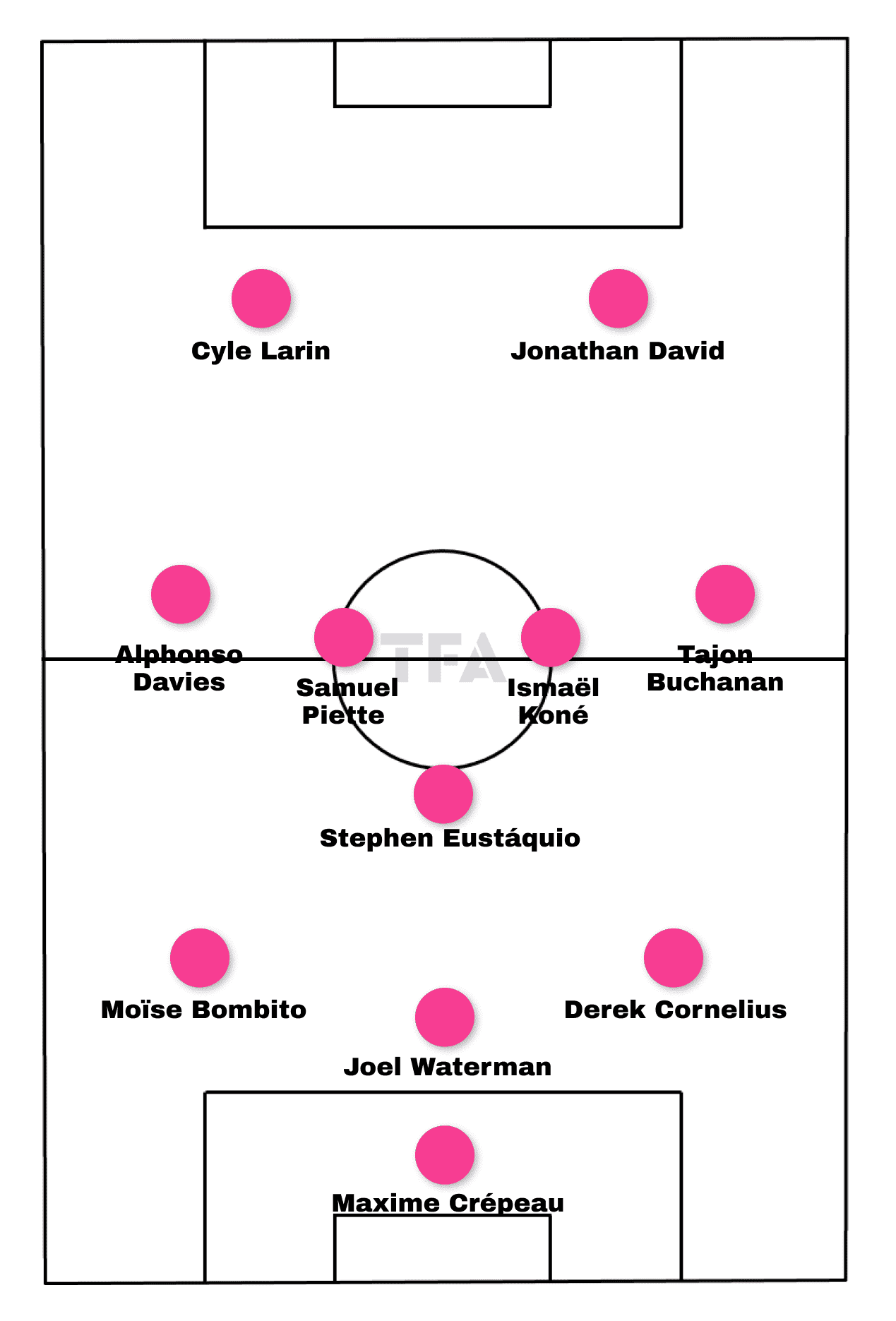
To guarantee more compactness in midfield and defence while being able to hurt any team using counterattacks and relying on their attacking duo, Jesse Marsch will most likely use a 3-5-2 formation during this tournament since it suits the players’ abilities the most.
Canada alternated between the 3-5-2, the 3-4-3, and the 4-4-2 in the latest period, yet the 3-5-2 remains the most adequate option for this team, especially when playing with three centre-backs.
With three centre-backs and two wing-backs retreating whenever necessary to make a wall of five, Canada can guarantee less danger from teams like Argentina and Chile while always being ready to launch counterattacks on the wings, trusting in these wing-backs.
Let’s not forget that Canada also have two excellent strikers up front who can punish any defence if they are in good form.
Marsch will rely on Maxime Crépeau as a starting goalkeeper since he has more experience and an advantage over the other goalkeepers, as he is in his peak years.
Dayne St.
Clair and Jonathan Sirois will be the backup goalkeepers during the tournament, and they have to be mentally and physically ready for emergency cases at any time.
The defensive line will most likely be composed of Colorado Rapids’ Moïse Bombito, Derek Cornelius and Joel Waterman, as these three players combine physical strength, strong marking qualities and passing accuracy.
Waterman will be the one to rely on for the build-up from the back since has a good vision and can play very well under pressure.
At the same time, Cornelius and Bombito will be very valuable in 1v1 marking, even though their mission will be far from simple against the likes of former Barcelona‘s Lionel Messi, Manchester City‘s Julián Álvarez, Inter Milan‘s Lautaro Martínez and Benfica’s Ángel Di María.
The midfield will be made up of two wing-backs: Bayern Munich’s Alphonso Davies and Inter’s Tajon Buchanan.
These two will have key roles to play throughout the tournament because they can be considered the quickest players in the team.
They will be the ones responsible for creating danger on the wings, dribbling, and trying to penetrate opposing defences near the touchline and, why not, near the box, too?
Porto’s Stephen Eustáquio, Watford’s Ismaël Koné and Montréal’s Samuel Piette will form the midfield line, as Eustáquio will most likely be the defensive midfielder.
At the same time, both Piette and Koné will be the central midfielders.
Up front, Jonathan David and Cyle Larin will have the advantage for the two striker positions as both players have good chemistry when they play alongside each other.
Also, these two strikers are considered the best Canadian forwards at the moment.
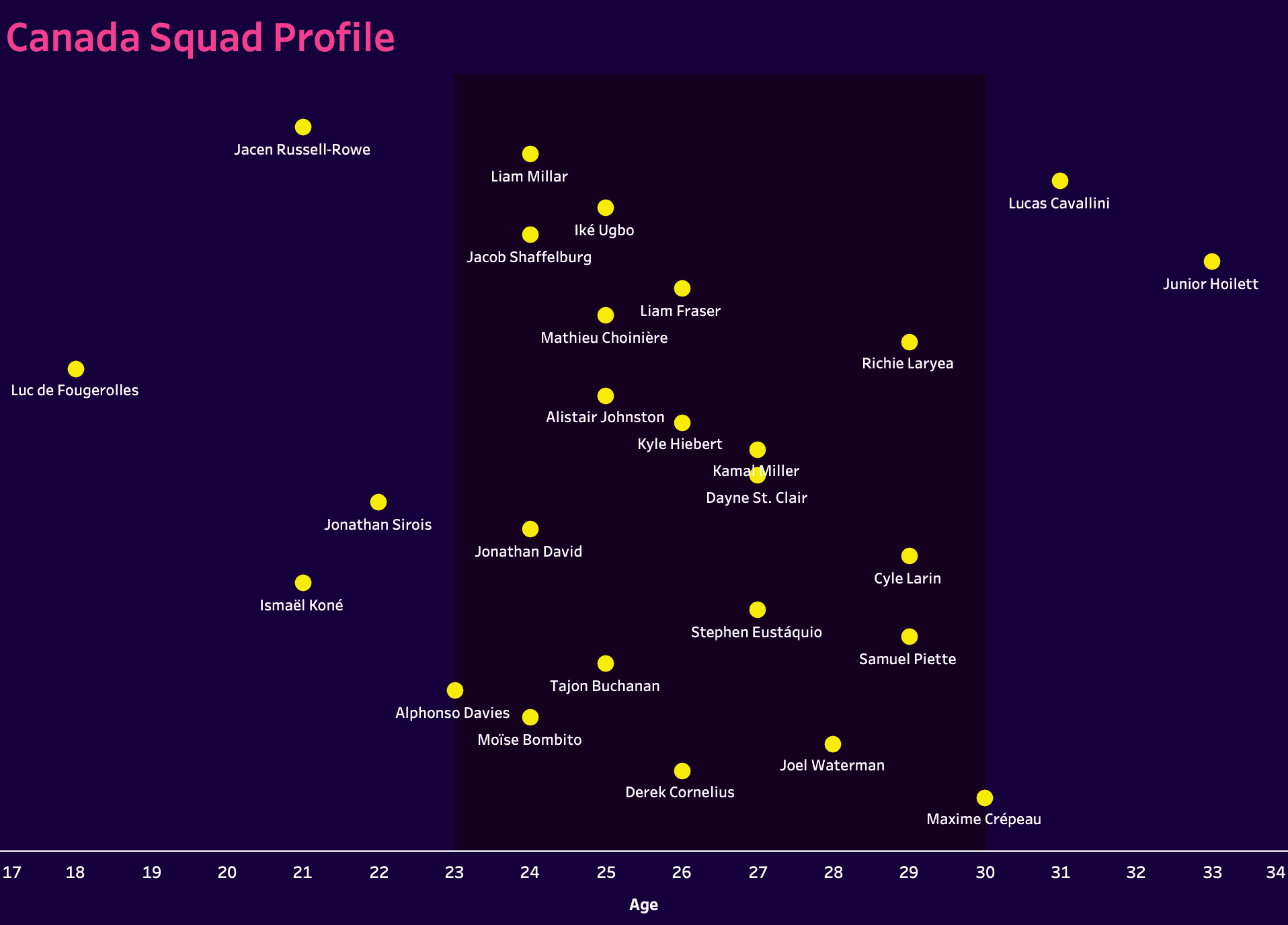
When looking at the age graphic of Canada, we notice that most players are actually during their peak years, including the goalkeeper Crépeau and Davies who is among the youngest players in the team, yet he is in his peak years.
The youngest players, however, include Fulham’s Luc de Fougerolles, Koné and Sirois.
What is positive as well is that only two players in this squad are past their peak years — Lucas Cavallini and Junior Hoilett.
Although it is always better to have relatively young players in order to benefit from their excellent physical abilities, the lack of experienced players in this team might represent a problem in terms of leadership on the pitch and in the dressing room.
No one in this team has the necessary experience to give valuable advice in key moments and know how to lead the team in complicated situations.
Attacking phase
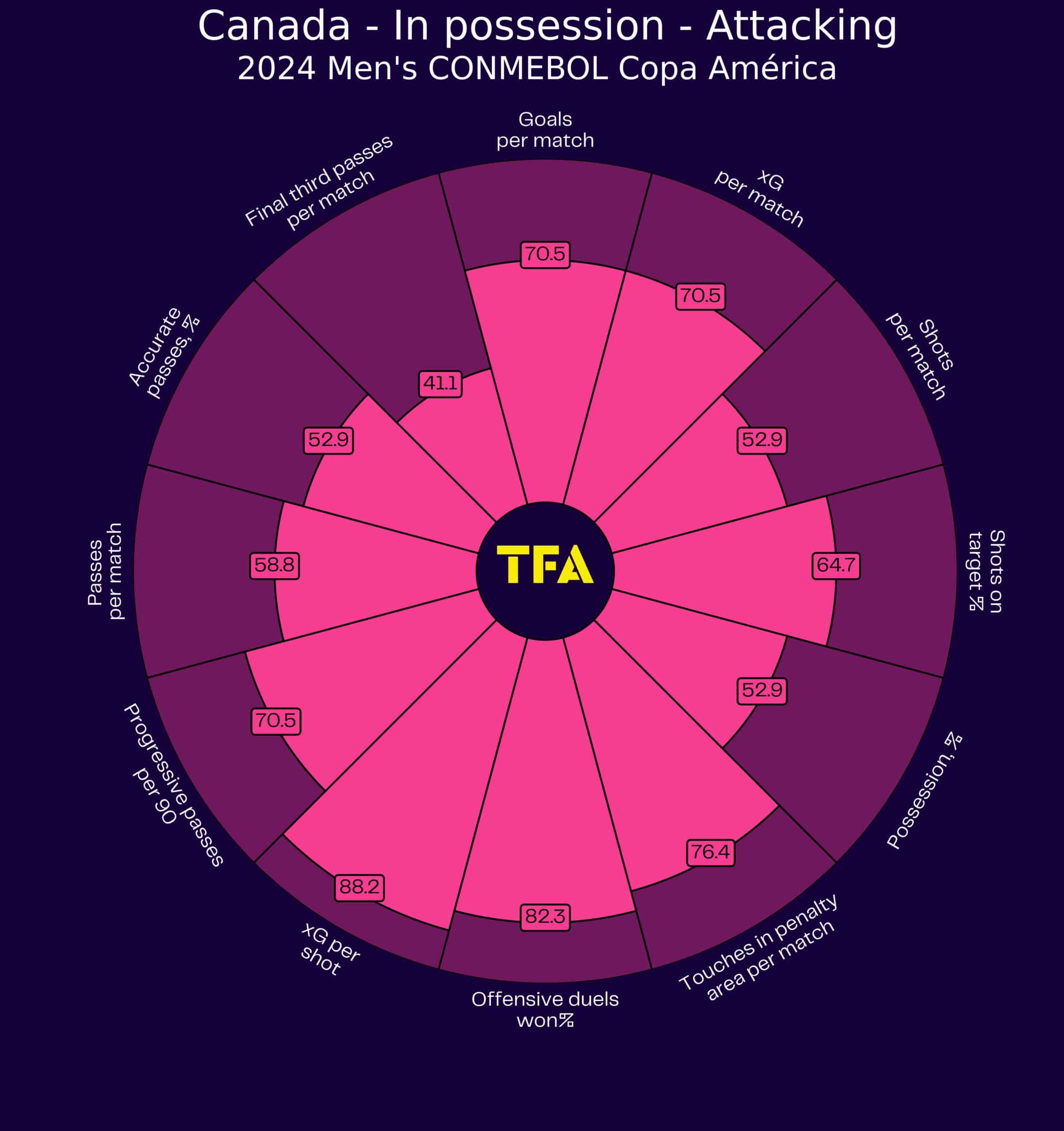
We’ll start our tactical analysis and team-focused scout report in the attacking phase.
When we look at Canada’s attacking graphic and recent form, we discover that what characterises this team mainly is their ability to win the majority of offensive duels per game, and that’s an aspect that Marsch can focus on to enhance the team’s goalscoring opportunities’ numbers.
One idea that can help exploit the offensive duels won per game is to intensify passes to both strikers and work on specific plans, passing combinations, and attacking movements that should be well coordinated and planned to confuse opposing defences.
In this regard, both Larin and David will have to work together a lot in terms of movements without the ball, blocking defenders to clear the way for the coming striker, and more.
All this can be achieved with the help of Davies, Buchanan, and one of the midfielders who joins the attack.
Canada are already doing this at times and are succeeding in creating the danger and gaps needed in their opposing defences to be able to score.
The most remarkable recent example is Larin’s goal against Trinidad and Tobago following Iké Ugbo’s excellent work without the ball.
The latter noticed that Larin was coming from behind and did what was necessary to fix his direct opponent and cover the ball completely with his body.
This provided a golden opportunity for Larin to take the ball and shoot without disturbance, as the one defender who was capable of disturbing Larin was completely blocked by Ugbo.
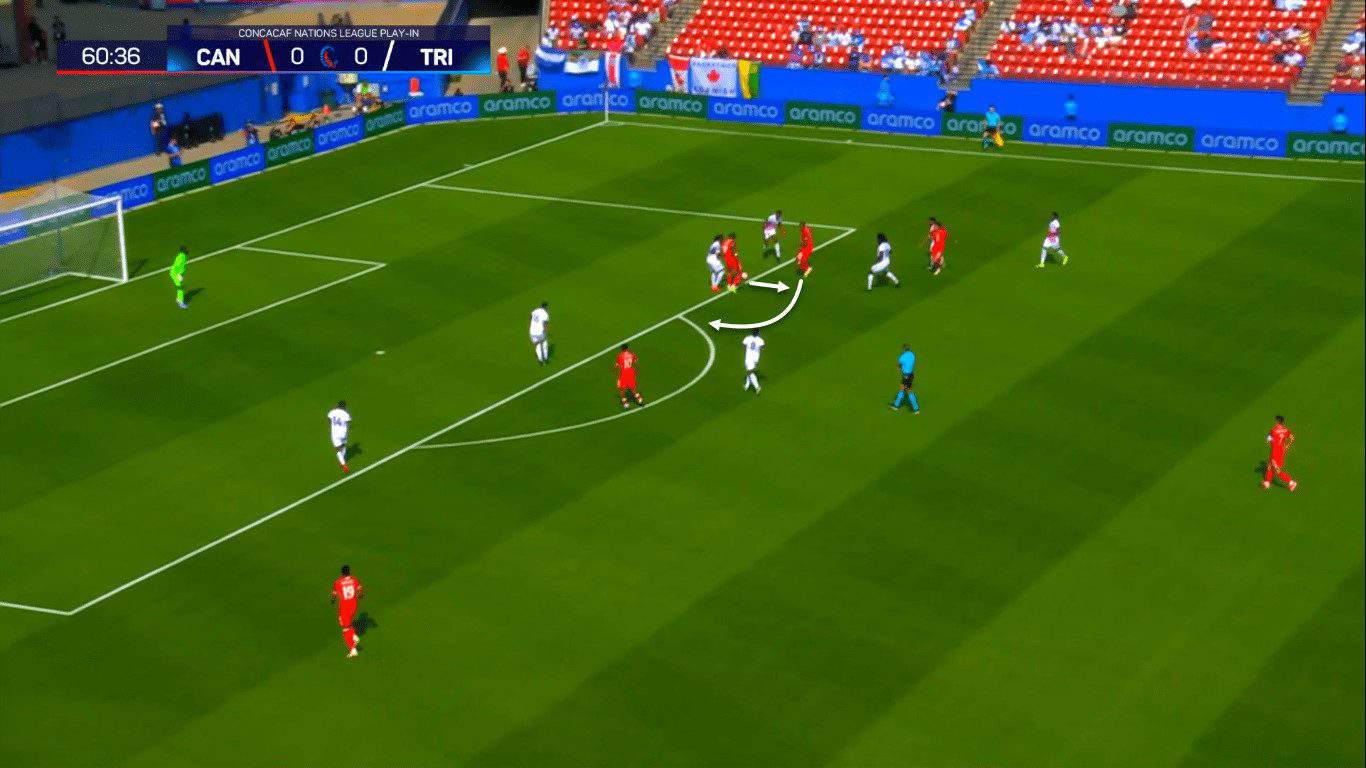
Apart from offensive duels, Canada score a relatively high number of goals per game, generate a high xG per 90 and an even higher number of touches inside the box per match.
The following action confirms the team’s attacking players’ ability to keep hold of the ball inside the box and get rid of defenders even when they try to surround one player, like Jamaica did in this example against Larin.
The latter, however, had enough physical abilities, dribbling skills and confidence to be able to get away from these defenders and penetrate further inside the box to find David moving in time and waiting to receive a pass and finish the action inside the net.
These kinds of actions need to be attempted in Copa América, too — but Canada will have to be aware that South American defences can be much more aggressive and tough to beat than those of teams from the CONCACAF.
That’s why it will be very important for Canada to vary their attacking plans.
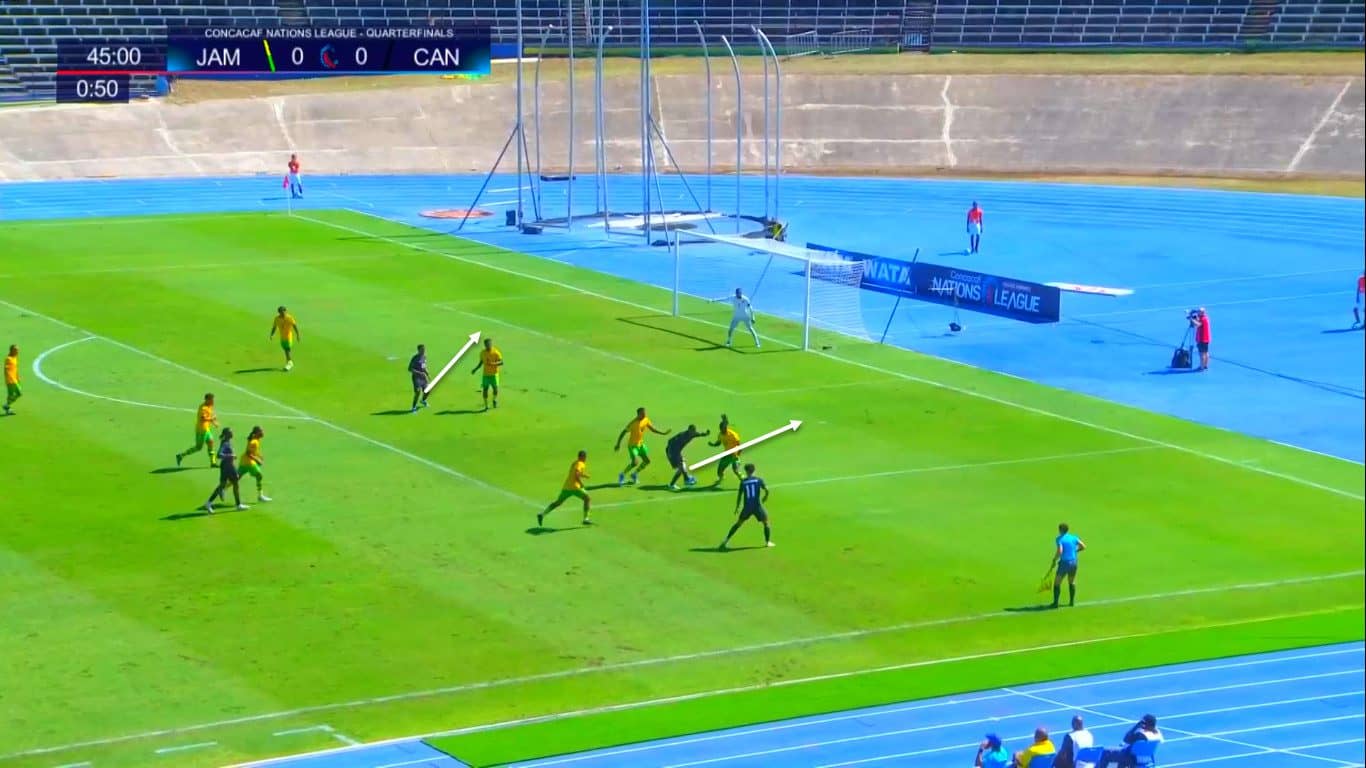
Canada will need to be aware that their passing accuracy numbers and final third passes per game are quite low and need to be improved ahead of this big tournament.
Providing more passes or crosses to the final third will automatically guarantee more goalscoring chances or at least attacking attempts.
It will be very useful to play as few misplaced passes per game as possible in order to benefit from the interceptions and the counterattacking possibilities that the team will be creating.
In the same vein, building on the team’s excellent passes from the wings will be beneficial as the team has some outstanding wingers who can always provide key passes from the wings, whether using surprising yet accurate backwards passes — like those shown in this example — or using crosses.
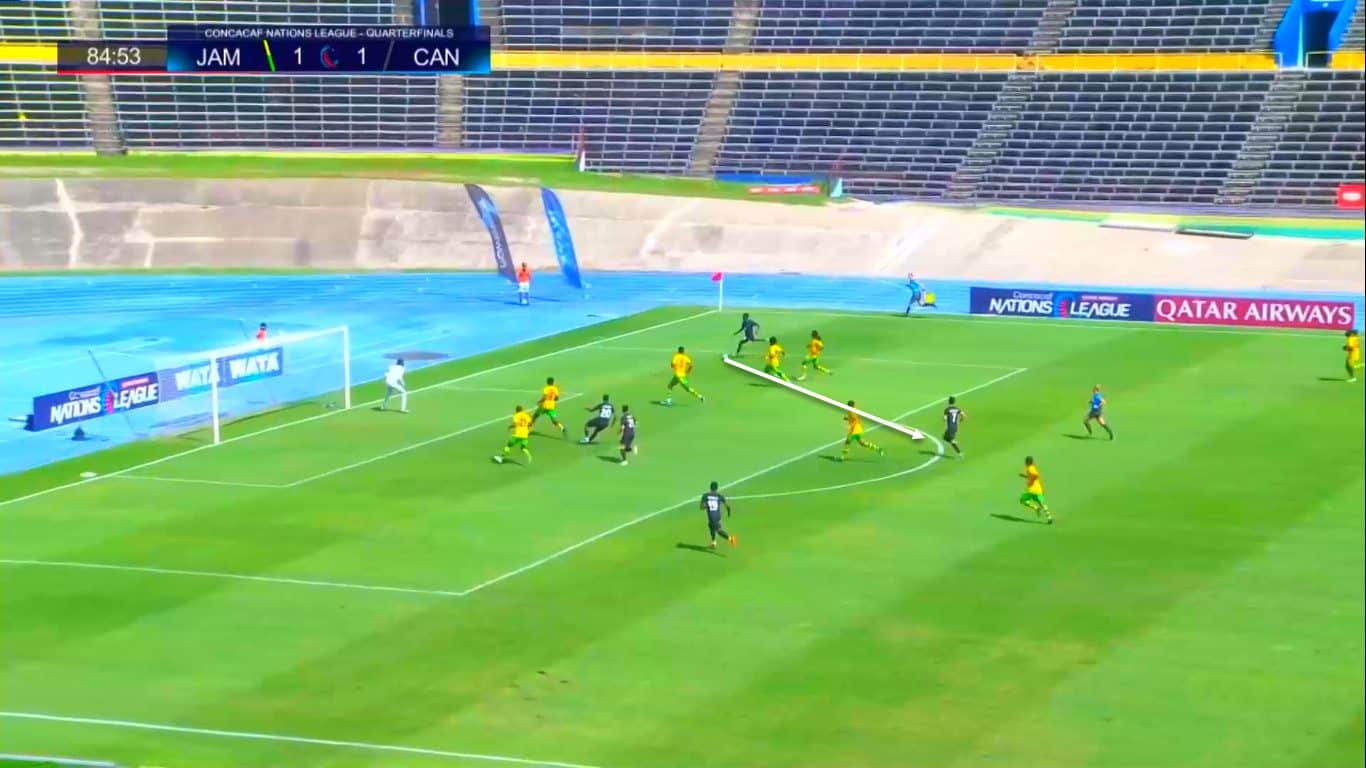
Defensive phase
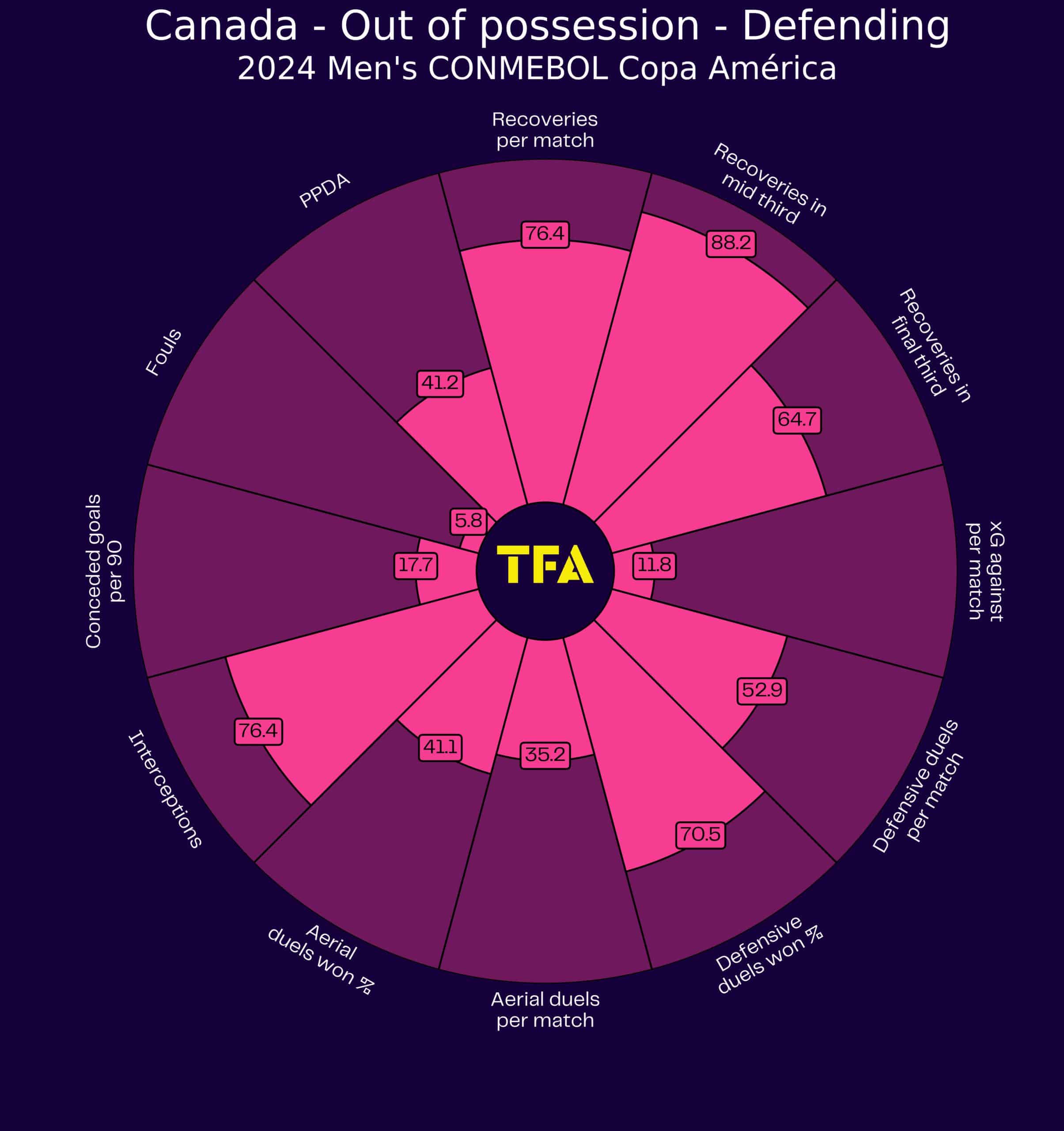
Moving onto the defensive part of our tactical analysis, the team certainly has some serious problems to fix in the long term.
But for now, the graphic highlights the fact that the team suffers in aerial duels, and this requires extensive work on defending set-pieces and on marking strikers in the air, especially.
Canada’s defensive line should also be attentive to the tricks that their opponents can apply when executing set pieces and not just focus on marking in the classic way.
Jamaica already tricked Canada during the execution of a free-kick that led to a goal, mainly due to poor marking from Canada’s defenders, who left an opponent alone because they excluded the possibility of passing to that player and thought that the set-piece taker would certainly be going for a cross.
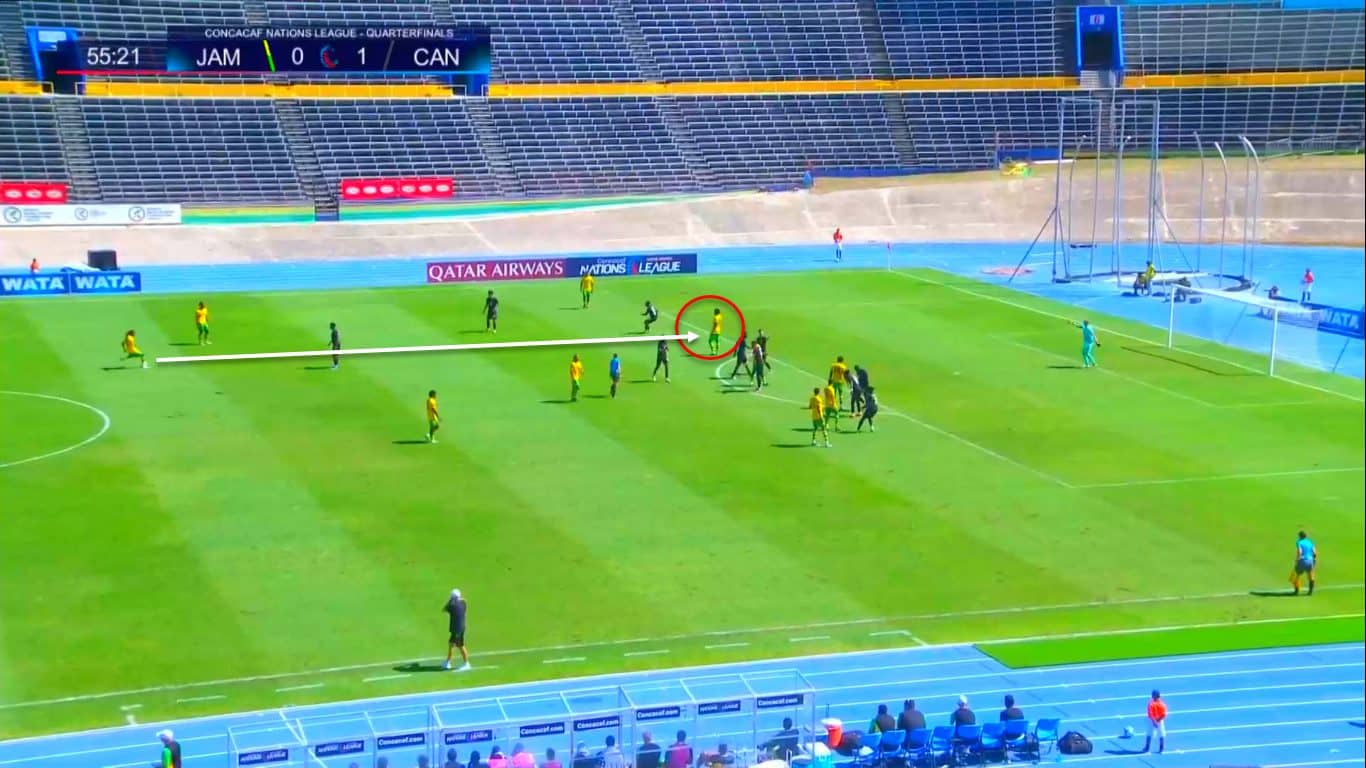
Moreover, knowing how to protect the ball under high pressure and avoiding errors inside the team’s own half will be necessary for this tournament, as it will be complicated to defend against teams like Argentina, for instance, after losing the ball in such a key area.
That’s why Canada will need to pay extra attention to these cases, and both midfielders and defenders will need to choose simpler options whenever they sense pressing opponents high.
Long passing towards the wings or the strikers can also be a suitable idea because the team’s attacking players have already proven their abilities to win offensive duels and aerial duels.
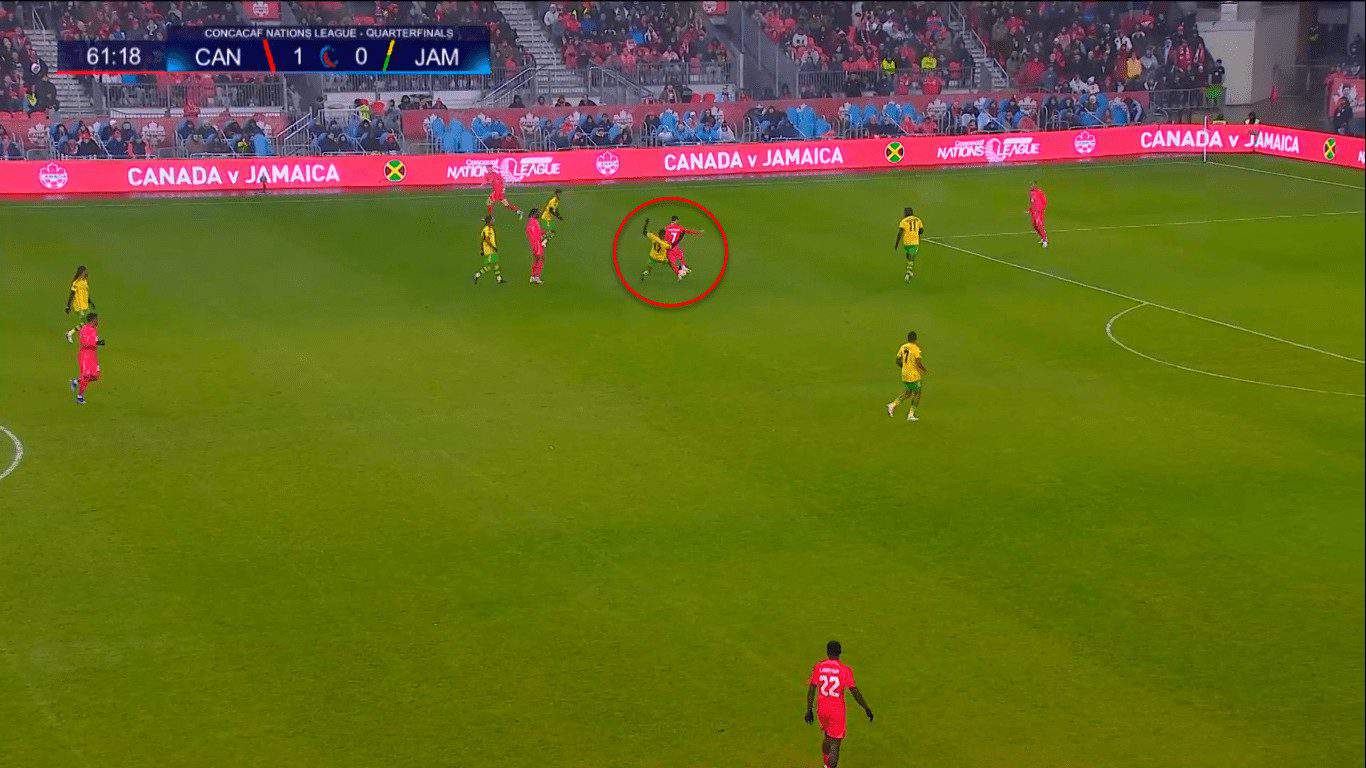
Transitions
Canada have shown on numerous occasions that they can be good enough in terms of attacking transitions, as they were able to create goalscoring opportunities by surprising opponents by relying on their players’ pace and ability to reach the final third quickly after intercepting the ball.
Canada’s attackers and midfielders usually like being put in such situations where they can launch counterattacks with three to four players providing passing options while the ball holder advances slowly towards the final third.
That being said, accelerating things a bit more can guarantee much more dangerous attacking transitions.
The rest of the attacking players also need to be quicker in advancing to provide passing choices in key areas.
The following example highlights how Canada can punish high defensive blocks with dangerous counterattacks.
Nevertheless, working on finishing in such actions is necessary as Canada tend to miss similar chances due to issues related to the final touch and to decision-making in front of goal.
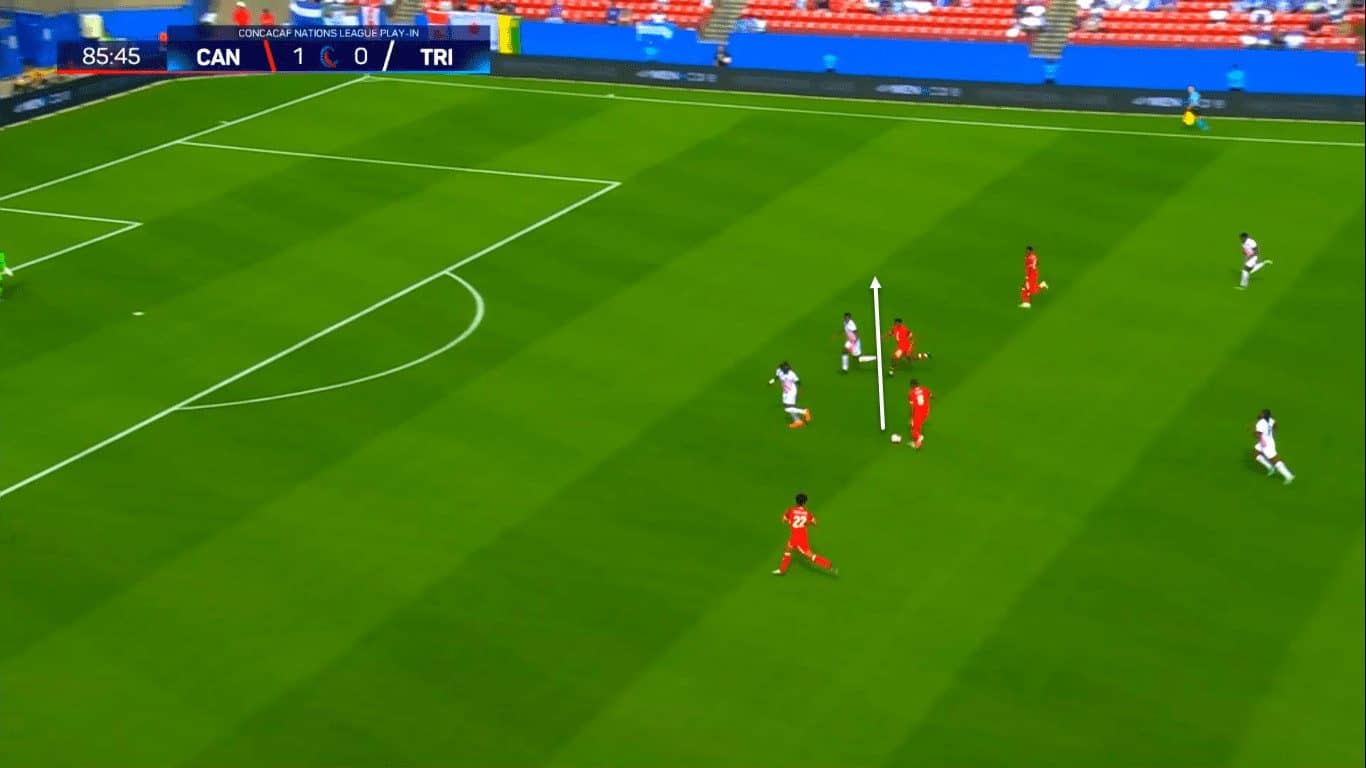
Regarding defensive transitions, it is fair to say that Canada might suffer a lot during this competition if they fail to organise themselves properly when losing the ball up front.
Playing with a high defensive block against powerful attacking teams should be very calculated as it can be considered a very risky and dangerous decision.
Knowing that many of the teams Canada will encounter have quicker attacking players than Canada’s, it will be wiser to avoid counterattacks by keeping a balanced/low defensive line most of the time and instructing three players to remain inside the team’s own half when in possession.
Defending with only two players can leave a lot of gaps in the team’s final third, as you can see in this example, and that’s why playing with three centre-backs represents a more secure formation for Canada.
And even if they switch to a 4-4-2 formation, for instance, the full-backs’ attacking contribution should always be monitored so that the defensive line remains balanced during the defensive transitions.
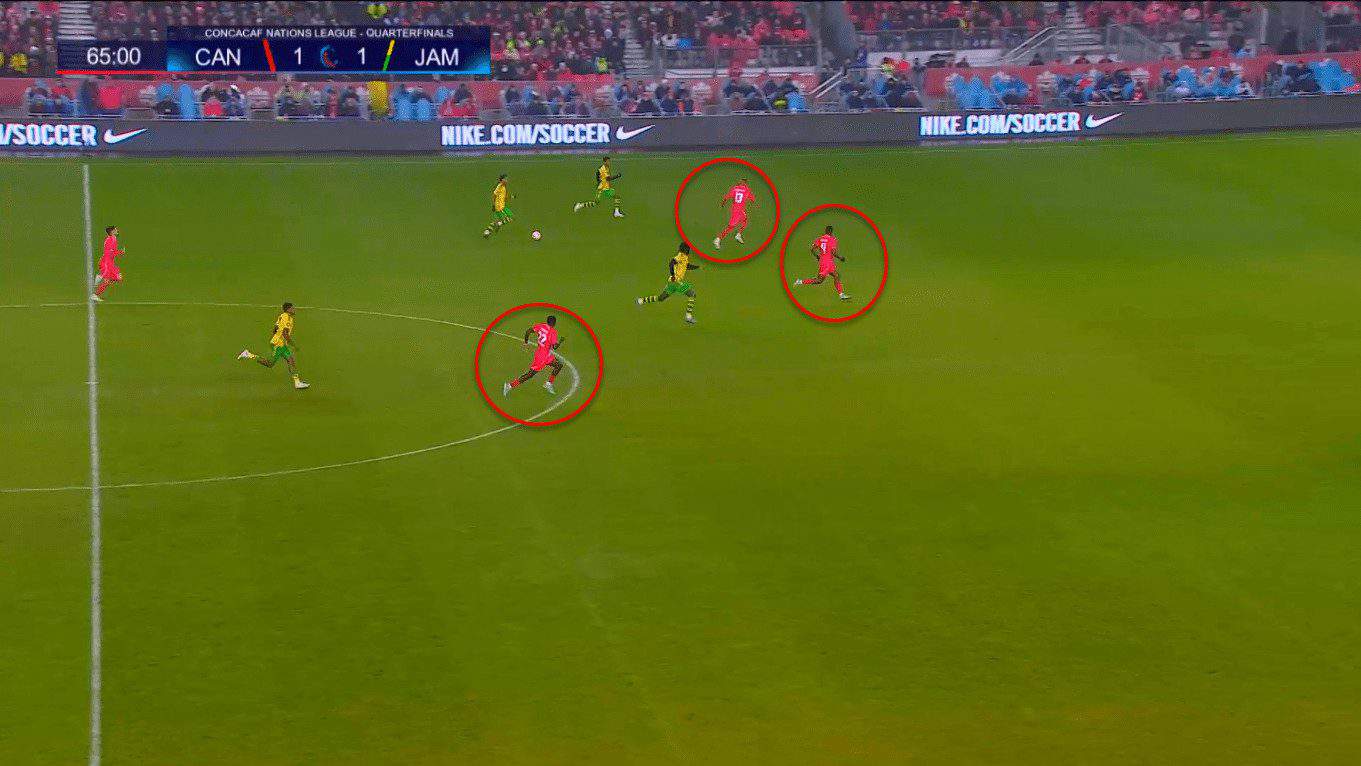
Defenders
If the team will use a back-three in defence, Cornelius, Waterman and Bombito will have to be aware of their duties and avoid individual or positional mistakes and be aggressive enough against powerful attacking players to avoid being penetrated.
Intelligence will also be needed during such games as most opponents have very talented and quick dribblers.
In addition, Kamal Miller and Kyle Hiebert will need to be mentally and physically ready to come in at any time as centre-backs when needed, even though they do not have the same defending qualities of the potential starting three.
Also, Marsch will have the possibility of switching to a back-four if needed, while using one of Alistair Johnston or Richie Laryea as right-backs and turning Davies to a left-back for instance.
Nevertheless, such changes need to be calculated and what is even more important will be to train the players on both formations especially in terms of positioning and duties.
Midfielders
The midfield will be the area that Marsch will have to focus on a lot during the preparation as it will most probably require a lot of tactical instructions from both the defensive and the attacking aspects.
Buchanan and Davies will have to be completely aware of the importance of their defensive duties when out of possession as it will be very dangerous to not retreat and mark opposing wingers.
At the same time, Eustáquio will be very important not only in the build-up but also in covering for his teammates and forming a second defensive line with Koné and Piette.
It is true that Canada do not have world-class choices on the bench, yet, names like Liam Fraser, Junior Hoilett and Jacob Shaffelburg can represent solid options during the games.
Forwards
Canada have an impressive attacking potential for the coming year and starting from this tournament even though things can be a bit difficult at first since Marsch has just been appointed and he will not have a lot of time to prepare for such a challenging competition.
Larin and David’s role will certainly be pivotal during this Copa América as Marsch will most probably rely on them as the attacking duo.
But at the same time, Iké Ugbo, Lucas Cavallini, Liam Millar and Jacen Russell-Rowe can provide the needed attacking depth too as these players can do well as wingers or strikers and replace the starting players especially when things don’t go well.
Key Player
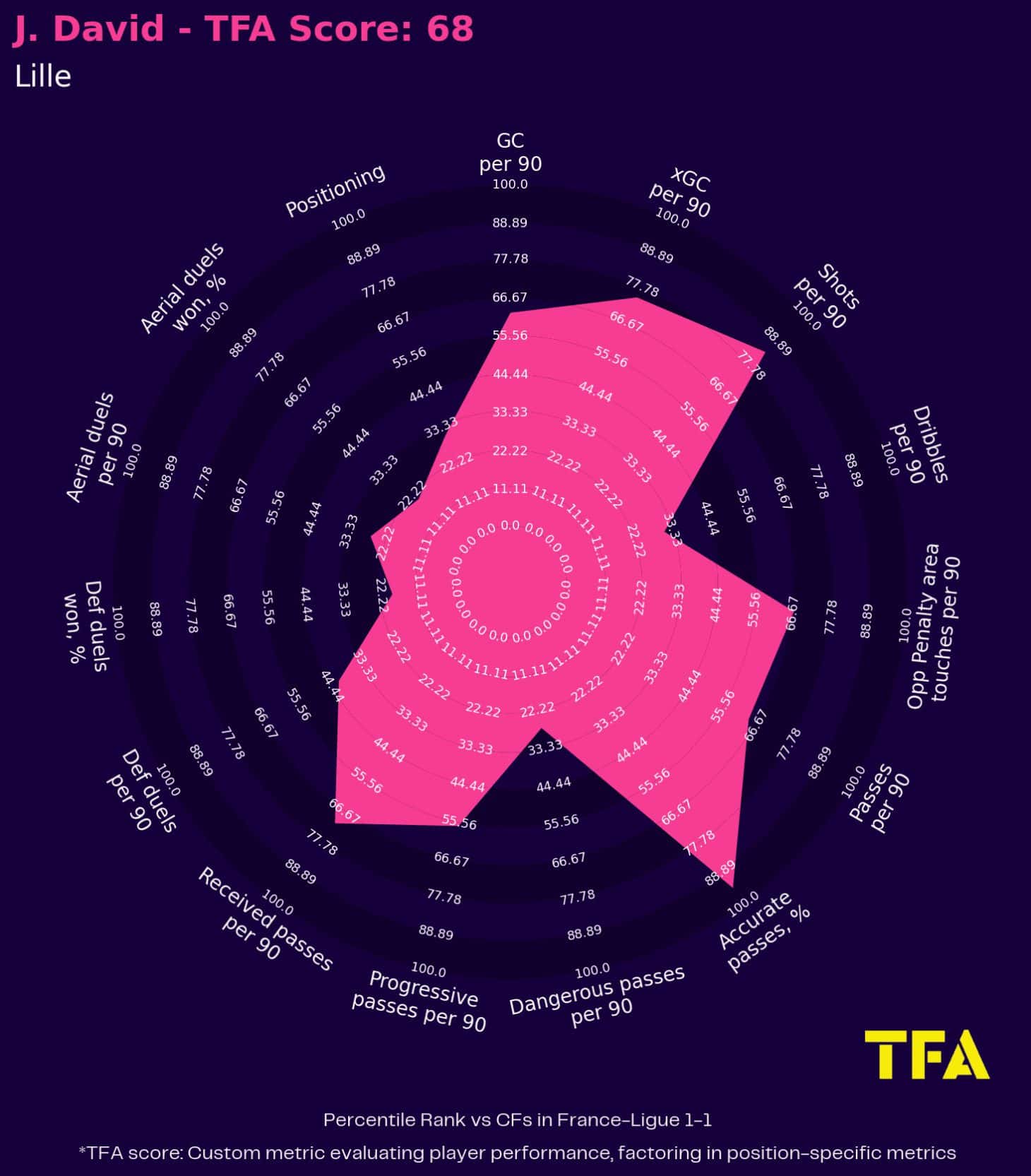
Jonathan David will be the team’s key player during this tournament simply because he has been in form lately and especially during 2024 at Lille, knowing that his actual form brought him interest from numerous European teams and notably from Milan.
The Canadian striker proved on numerous occasions that he can score using both feet while keeping high accuracy rates in terms of shooting.
Although the graphic shows that he is not good enough in the air, it confirms that David shoots a lot per match and has a very remarkable passing accuracy average especially when considering that he is a striker and not a midfielder, which makes him even more valuable.
That also means that David can be relied on in playmaking thanks to his excellent passing qualities and we saw him retreat a lot to receive the ball and provide key passes inside the final third.
Moreover, David will have to share duties with Larin and be intelligent enough to know what to do by himself and what to leave for Larin in order to complement each other inside the box.
It should also be noted that David is a very good and quick dribbler and can use his pace to make his dribbles even more efficient.
Marsch should know how to benefit from Lille’s striker attacking-wise and the latter will have to do his best to make the difference upfront as Canada’s hopes will partly be on his shoulders.
Tournament prediction
With two friendly games to be played soon against the Netherlands and France, Marsch will finally get a chance to discover his team on the pitch and experiment a little bit as this would help him identify the team’s strengths and weaknesses.
In a group having Argentina, Chile and Peru, we can say that Canada have equal chances to qualify as second alongside Chile, meaning that both Canada and Chile will battle for the second spot while Argentina will more likely finish at the top of the group and Peru as fourth.
Even though Marsch has been appointed very recently, Canada have the abilities needed to win against Peru if they don’t fall in the trap of underestimation of their opponent, as they also have what is needed to win or draw against Chile.
However, it will be complicated yet not impossible for them to win against Argentina.

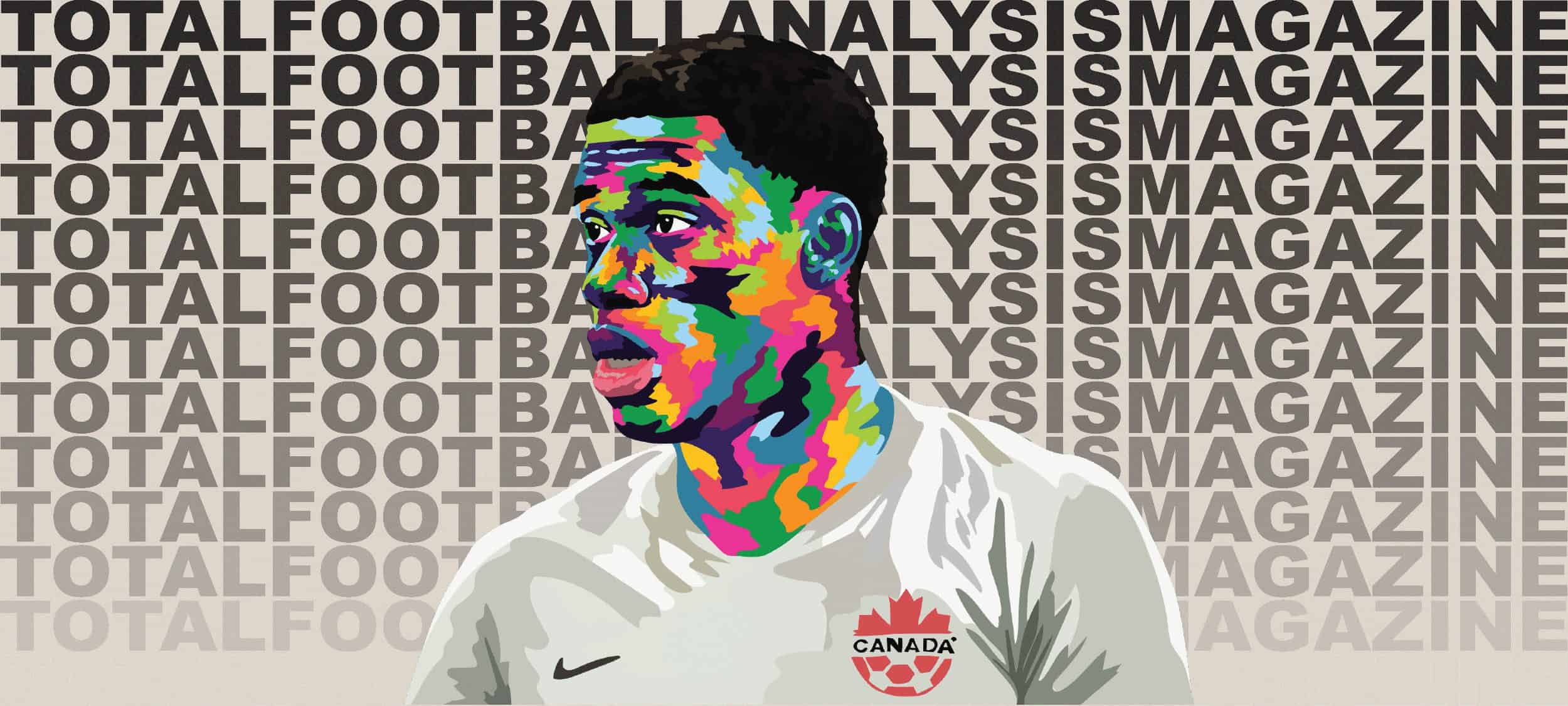



Comments